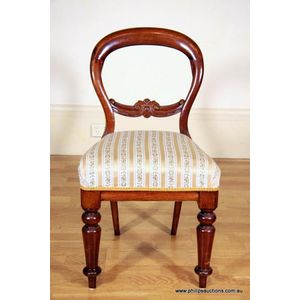William IV Mahogany Dining Chairs (1830s)
You must be a subscriber, and be logged in to view price and dealer details.
Subscribe Now to view actual auction price for this item
When you subscribe, you have the option of setting the currency in which to display prices to $Au, $US, $NZ or Stg.
- Mahogany - Mahogany is a dense, close grained red-coloured timber from the West Indies and Central America. It was first imported into Europe in the the early 18th century and its use continued through the 19th century. It was popular for furniture making because of its strength, the wide boards available, the distinctive grain on some boards, termed flame mahogany and the rich warm colour of the timber when it was polished.. The "flame" was produced where a limb grew out from the trunk of the tree, and this timber was usually sliced into veneers for feature panels on doors, backs and cornices.
Some terms used to describe mahogany relate to the country from which it originally came, such as "Cuban" mahogany, "Honduras" mahogany etc. However unless the wood has been tested the names assigned are more a selling feature, rather than a true indication of the timber's origin. - Turning - Any part of a piece of furniture that has been turned and shaped with chisels on a lathe. Turned sections include legs, columns, feet, finials, pedestals, stretchers, spindles etc. There have been many varieties and fashions over the centuries: baluster, melon, barley-sugar, bobbin, cotton-reel, rope-twist, and so on. Split turning implies a turned section that has been cut in half lengthwise and applied to a cabinet front as a false decorative support.
- Regency Period - The Regency period in English furniture design refers to the period when King George III, was declared unfit to rule in 1811, and his son ruled as proxy as Prince Regent, until 1820, and then, after the death of his father as George IV until his death in 1830. The Regency period was preceded by the Georgian period (George I, George II, and George III: 1714 - 1811), and was followed by the William IV period, which only lasted until 1837 when William IV died as was succeeded by Queen Victoria.
- Baluster (furniture) - An architectural term for a column in a balustrade or staircase, often defined as a "vase shape". The shape is extensively used in furniture and decorative arts.
In furniture, it is used to describe a chair or table leg turned in that form, or more usually as an inverted baluster, with the bulbous section to the top. Less commonly used to describe a chair back that has the outline of a baluster. A baluster may also be split and applied to the front of a cupboard for ornamentation.
For ceramics and silver items it is often used to describe the shape of the whole item, rather than a part.
In Georgian glassware, the shape is commonly seen in the stem of glasses. - Circa - A Latin term meaning 'about', often used in the antique trade to give an approximate date for the piece, usually considered to be five years on either side of the circa year. Thus, circa 1900 means the piece was made about 1900, probably between 1895 and 1905. The expression is sometimes abbreviated to c.1900.
- William Iv - William IV was King of the United Kingdom and King of Hanover from 26 June 1830 until his death in 1837, and in English furniture design it represented the brief period between the end of the Regency period, and the beginning of the Victorian period.
- Jacquard Fabric - Jacquard fabric is woven on a jacquard loom, which allows intricate and complex patterns to be created. The jacquard loom is controlled by a system of punched cards or a computer program that controls the movement of the loom and allows for the creation of complex patterns in the fabric.
Jacquard fabric is known for its elaborate and detailed designs, which can include intricate floral patterns, geometric designs, and other complex motifs. The patterns are woven into the fabric, rather than printed or embroidered, which gives them a unique texture and depth.
Jacquard fabrics can be made from a variety of fibress, including silk, cotton, wool, and synthetic materials. They are often used for upholstery, drapery, and other decorative applications, as well as for clothing such as dresses, suits, and jackets.
This item has been included into following indexes:
-
chairs, sets of 4, style or period
- all styles 491
- balloon back 46
- bar back / Trafalgar back / spade back 53
- Regency 35
- William IV 17
- chairs, sets of 4, timber - mahogany 102
Visually similar items

A Victorian mahogany balloon back chair, mid 19th century, the chair with a shaped plain frame and a dipped crest, a gently pulvinated straight seating rail with a drop in seat and raised upon slender turned and ribbed baluster legs, upholstered in a flora

A set of four Victorian rosewood dining chairs, 19th century, the waisted chairs with trefid crests and carved mid rails, with old gold velvet stuffover seats and raised on turned legs with long centurion skirt style decoration and toupie feet, height 84 c

A set of ten mahogany chairs, six late Victorian, four later, balloon back chairs of simple C scroll design, stuffed over seats terminating in turned and carved baluster legs. Height 89 cm. Width 47 cm. Depth 55 cm

A set of four Victorian mahogany chairs, second half 19th century, the balloon back chairs each with a curved mid rail with a foliate motif in relief to stuffover seats with square seating rails and raised on ball and baluster legs; upholstered in gold and
